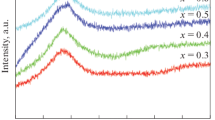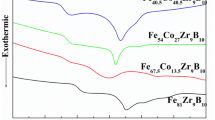Abstract
The Gd60Co30Fe10 alloy ribbons with different solidification cooling rates were prepared by modifying the melt-spinning speed of 6.0, 12.5, 25.0 and 50.0 m·s−1. With cooling rate decreasing, the (Fe,Co)5Gd and hcp-Gd nanocrystalline was in situ precipitated among the amorphous matrix, which resulted in the composition change of the amorphous phase. Because of the only slight amount of crystalline phase in Gd60Co30Fe10 alloys, the magnetic and magnetocaloric properties mainly depend on the amorphous phase, and all the magnetic entropy change versus temperature (|ΔSM|–T) curves are table-like, indicating the suitability for Ericsson cycle. The magnetic transition temperature of the Gd60Co30Fe10 alloy at a melt-spinning speed of 6.0 m·s−1 shifted obviously to the lower value with the applied magnetic fields increasing. The peak value of magnetic entropy change (|ΔSMpk|) is 2.19 J·kg−1·K−1 at 217 K under the magnetic field change of 0–2 T, and the table-like region is 200–230 K. It was proved that the moderate reduction of the cooling rate will not deteriorate the magnetocaloric performance of the Gd60Co30Fe10 ribbons seriously.
摘要
使用熔体旋淬法, 通过调节辊轮转速为6.0, 12.5, 25.0 和 50.0 m·s−1, 制备了不同冷却速度的Gd60Co30Fe10合金条带。随着冷却速度的降低, (Fe,Co)5Gd和hcp-Gd纳米晶从非晶基体中原位析出, 使非晶相的成分发生变化。由于析出的晶相含量较低, 因此整个样品的磁性能和磁热性能主要取决于非晶相, 磁熵变温变 (|ΔSM|-T) 曲线均呈平台型, 表明其适用于Ericsson循环。辊轮转速为6.0 m·s−1时制备的Gd60Co30Fe10合金的磁转变温度随着外加磁场的增加明显向低温偏移, 在磁场变化为0-2 T的条件下, 217 K时磁熵变峰值 (|ΔSMpk|) 为2.19 J·kg−1·K−1, 平台区为200-230 K。本研究证明适度的降低冷却速度, 不会使Gd60Co30Fe10合金条带的磁热性能表现严重恶化。







Similar content being viewed by others
References
Tegus O, Brück E, Buschow KHJ, de Boer FR. Transition-metal-based magnetic refrigerants for room-temperature applications. Nature. 2002;415(6868):150.
Pecharsky VK, Gschneidner KA Jr. Giant magnetocaloric effect in Gd5(Si2Ge2). Phys Rev Lett. 1997;78:4494.
de Oliveira NA, von Ranke PJ. Theoretical aspects of the magnetocaloric effect. Phys Rep. 2010;489(4–5):89.
Xia L, Wu C, Chen SH, Chan KC. Magneto-caloric effect of a Gd50Co50 amorphous alloy near the freezing point of water. AIP Adv. 2015;24(9):4494.
Franco V, Blazquez JS, Ingale B, Conde A. The magnetocaloric effect and magnetic refrigeration near room temperature: materials and models. Annu Rev Mater Res. 2012;42:305.
Ma LY, Gan LH, Chan KC, Ding D, Xia L. Achieving a table-like magnetic entropy change across the ice point of water with tailorable temperature range in Gd-Co-based amorphous hybrids. J Alloys Compd. 2017;723:197.
Ram NR, Prakash M, Naresh U, Kumar NS, Sarmash TS, Subbarao T, Kumar RJ, Kumar GR, Naidu KCB. Review on magnetocaloric effect and materials. J Supercond Nov Magn. 2018;31(7):1971.
Miao XF, Hu SY, Xu F, Brück E. Overview of magnetoelastic coupling in (Mn, Fe)2(P, Si)-type magnetocaloric materials. Rare Met. 2018;37(9):723.
Zheng D, Jing C, Lu B, Li Z, Xu K. Martensitic transformation, magnetocaloric effect and phase transition strain in Ni50Mn36–xGexSn14 Heusler alloys. Rare Met. 2016. https://doi.org/10.1007/s12598-016-0820-6.
Wang L, Ye RC, Liu XX, Li JL, Liu PJ, Long Y. Off-STOICHIOMETRIC La1+x(Fe, Si)13 magnetic refrigeration materials prepared by powder metallurgy. Chin J Rare Met. 2019;43(7):774.
Brück E. Developments in magnetocaloric refrigeration. J Phys D: Appl Phys. 2005;38(23):R381.
Wang LC, Shen BG. Magnetic properties and magnetocaloric effects of PrSi. Rare Met. 2014;33(3):239.
Brown GV. Magnetic heat pumping near room temperature. J Appl Phys. 1976;47(8):3673.
Dan’kov SY, Tishin AM, Pecharsky VK, Gschneidner KA Jr. Magnetic phase transitions and the magnetothermal properties of gadolinium. Phys Rev B. 1998;57(6):3478.
Thanveer T, Ramanujan RV, Thomas S. Magnetocaloric effect in amorphous and partially crystallized Fe40Ni38Mo4B18 alloys. AIP Adv. 2016;6(5):055322.
Wu C, Ding D, Xia L, Chan KC. Achieving tailorable magneto-caloric effect in the Gd–Co binary amorphous alloys. AIP Adv. 2016;6(3):035302.
Zhang HH, Cui ZD, Zhu SL, Guo SW, Yang XJ, Inoue A. Microstructure and mechanical properties of TC4 joints brazed with Ti–Zr–Cu–Sn amorphous filler alloy. Rare Met. 2020. https://doi.org/10.1007/s12598-020-01424-2.
Li ZD, Zhang WW, Li GT, Li SS, Ding HS, Zhang T, Song YG. Magnetic field annealing of FeCo-based amorphous alloys to enhance thermal stability and Curie temperature. Rare Met. 2018. https://doi.org/10.1007/s12598-018-1069-z.
Balfour EA, Ma Z, Fu H, Hadimani RL, Jiles DC, Wang L, Luo Y, Wang SF. Table-like magnetocaloric effect in Gd56Ni15Al27Zr2 alloy and its field independence feature. J Appl Phys. 2015;118(12):123903.
Tian HC, Zhong XC, Liu ZW, Zheng ZG, Min JX. Achieving table-like magnetocaloric effect and large refrigerant capacity around room temperature in Fe78-xCexSi4Nb5B12Cu1 (x = 0–10) composite materials. Mater Lett. 2015;138:64.
Álvarez P, Sánchez Llamazares JL, Gorria P, Blanco JA. Enhanced refrigerant capacity and magnetic entropy flattening using a two amorphous FeZrB(Cu) composite. Appl Phys Lett. 2011;99(23):232501.
Zhong XC, Shen XY, Mo HY, Jiao DL, Liu ZW, Qiu WQ, Zhang H, Ramanujan RV. Table-like magnetocaloric effect and large refrigerant capacity in Gd65Mn25Si10–Gd composite materials for near room temperature refrigeration. Mater Today Commun. 2018;14:22.
Liu GL, Zhao DQ, Bai HY, Wang WH, Pan MX. Room temperature table-like magnetocaloric effect in amorphous Gd50Co45Fe5 ribbon. J Phys D Appl Phys. 2016;49(5):055004.
Mo HY, Zhong XC, Jiao DL, Liu ZW, Zhang H, Qiu WQ, Ramanujan RV. Table-like magnetocaloric effect and enhanced refrigerant capacity in crystalline Gd55Co35Mn10 alloy melt spun ribbons. Phys Lett A. 2018;382(25):1679.
Wang ZW, Yu P, Cui YT, Xia L. Near room temperature magneto-caloric effect of a Gd48Co52 amorphous alloy. J Alloys Compd. 2016;658:598.
Ghosh J, Mazumdar S, Das M, Ghatak S, Basu AK. Microstructural characterization of amorphous and nanocrystalline boron nitride prepared by high-energy ball milling. Mater Res Bull. 2008;43(4):1023.
Ichitsubo T, Matsubara E, Numakura H, Tanaka K. Glass-liquid transition in a less-stable metallic glass. Phys Rev B. 2005;72(5):052201.
Xiang S, Li Q, Zuo M, Cao D, Li H, Sun Y. Influence of the preparation cooling rate on crystallization kinetics of Fe74Mo6P13C7 amorphous alloys. J Non-Cryst Solids. 2017;475(1):116.
Schwarz B, Mattern N, Luo Q, Eckert J. Magnetic properties and magnetocaloric effect of rapidly quenched Gd–Co–Fe–Al alloys. J Magn Magn Mater. 2012;324(8):1581.
Yang SX, Zheng XQ, Yang WY, Xu JW, Liu J, Xi L, Zhang H, Wang LC, Xu ZY, Zhang JY, Wu YF, Ma XB, Chen DF, Yang JB, Wang SG, Shen BG. Tunable magnetic properties and magnetocaloric effect of TmGa by Ho substitution. Phys Rev B. 2020;102:174441.
Law JY, Franco V, Moreno-Ramírez LM, Conde A, Karpenkov DY, Radulov I, Skokov KP, Gutfleisch O. A quantitative criterion for determining the order of magnetic phase transitions using the magnetocaloric effect. Nat Commun. 2018;9:2680.
Romero Gómez J, Ferreiro Garcia R, De Miguel CA, Romero Gómez M. Magnetocaloric effect: a review of the thermodynamic cycles in magnetic refrigeration. Renew Sustain Energy Rev. 2013;17:74.
Belo JH, Amaral JS, Pereira AM, Amaral VS, Araújo JP. On the Curie temperature dependency of the magnetocaloric effect. Appl Phys Lett. 2012;101(7):242407.
McMichael RD, Ritter JJ, Shull RD. Enhanced magnetocaloric effect in Gd3Ga5−xFexO12. J Appl Phys. 1993;73(10):6946.
Hashimoto T, Numasawa T, Shino M, Okada T. Magnetic refrigeration in the temperature range from 10 K to room temperature: the ferromagnetic refrigerants. Cryogenics. 1981;21(11):647.
Masumoto T, Egami T. Designing the composition and heat treatment of magnetic amorphous alloys. Mater Sci Eng. 1981;148(2):147.
Miyazaki T, Hayashi K, Yamaguchi S. Magnetization, curie temperature and perpendicular magnetic anisotropy of evaporated Co-rare earth amorphous alloy films. J Magn Magn Mater. 1988;75(3):252.
Zhang HY, Ouyang JT, Ding D, Li HL, Wang JG, Li WH. Influence of Fe substitution on thermal stability and magnetocaloric effect of Gd60Co40−xFex amorphous alloy. J Alloys Compd. 2018;769:186.
Fang Y, Yu Z, Peng G, Feng T. Near room-temperature magnetocaloric effect in amorphous Fe–Sc alloys: the effect of minor Co additions. J Non-Cryst Solids. 2019;505:211.
Fujita A, Fukamichi K. Control of large magnetocaloric effects in metamagnetic La(FexSi1−x)13 compounds by hydrogenation. J Alloys Compd. 2005;404–406:554.
Acknowledgements
This work was financially supported by the National Natural Science Foundation of China (No. 51701003), the Natural Science Foundation of Anhui Province (No. 1908085ME147) and the International Cooperation and Exchanges in Anhui Provincial Key Project of Research (No. 202004b11020010).
Author information
Authors and Affiliations
Corresponding author
Rights and permissions
About this article
Cite this article
Zhang, HY., Zhang, ZY., Xu, YF. et al. Microstructure and magnetocaloric properties of partially crystallized Gd60Co30Fe10 amorphous alloy prepared by different solidification cooling rates. Rare Met. 41, 246–253 (2022). https://doi.org/10.1007/s12598-021-01745-w
Received:
Revised:
Accepted:
Published:
Issue Date:
DOI: https://doi.org/10.1007/s12598-021-01745-w




